Sri Lanka |
|
|
|
| Übersicht – Contents: | |
Sri Lanka |
|
|
|
| Übersicht – Contents: | |
Flaggen – Flags: |
|
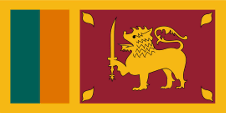 |
seit/since 1978, |
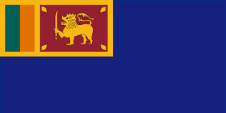 |
seit/since 1978, |
 |
seit/since 1978, |
 |
seit/since 2010, |
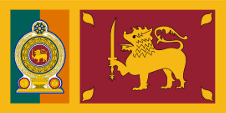 |
seit/since 1978, |
historische Flaggen – historical Flags: |
|
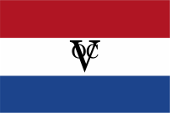 |
1639–1796, |
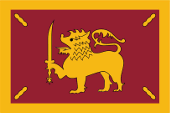 |
ca. 1798–1815, |
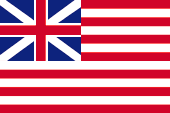 |
1795–1802, |
 |
1802–1948, Union Flag → quasi Nationalflagge, |
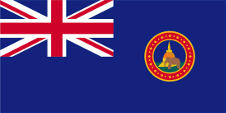 |
1875–1948, Flagge der Regierung (Staatsflagge) – flag of the government (state flag), Seitenverhältnis – ratio = 1:2, Quelle/Source, nach/by: Flags of the World |
 |
1875–1948, |
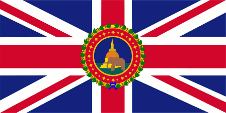 |
ca.1875–1948, Flagge des Gouverneurs – flag of the Governor, Seitenverhältnis – ratio = 1:2, Quelle/Source, nach/by: Flags of the World |
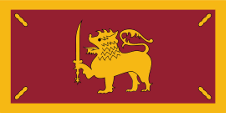 |
1948–1951, |
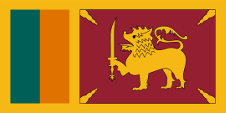 |
1951–1972, |
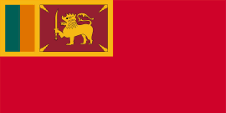 |
1951–1972(?), |
 |
1951–1972(?), |
 |
1951–1972, |
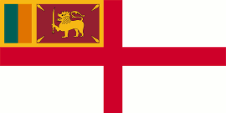 |
1951–1972, |
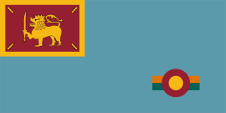 |
1951–1971, |
 |
1948–1972, Flagge des Generalgouverneurs – flag of the Governor General, Seitenverhältnis – ratio = 1:2, Quelle/Source, nach/by: Flags of the World |
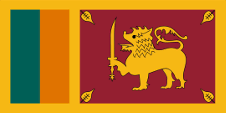 |
1972–1978, |
Sezessionsstaat Tamil Eelam – Secessionist State of Tamil Eelam: |
| Die heutige Flagge Sri Lankas wurde offiziell am 22.05.1972 eingeführt und am 07.09.1978 in den Ecken des rotbraunen Feldes noch mal ein klein wenig verändert. Sie zeigt innerhalb eines gelben Rahmens ein großes rotbraunes Feld auf der rechten Seite, und links – in einem kleineren Feld – zwei senkrechte Streifen in Grün und Safran-Gelb. Innerhalb des rotbraunen Feldes ist ein gelber schwerttragender Löwe zu sehen, und in den Ecken gelbe Blätter des Bo-Baumes. Das große rechte Feld entspricht der Flagge des alten singhalesischen Königreiches von Kandy (Königreich Udarata) mit dem Königsemblem des Goldenen Löwen. Gelb ist die Farbe des Buddhismus. Der gelbe Rahmen um die Flagge symbolisiert den Schutz des Landes durch diese Religion. Der grüne Streifen steht für die moslemische Minderheit des Landes, und der safran-gelbe für die hinduistische Minderheit der Tamilen. Die Farben der Flagge sind definiert und niedergelegt in einem Dokument der Sri Lanka Standards Institution (SLSI), wahrscheinlich von 2020, unter anderem auch im Farbraum RGB, Gelb 247-183-24, Bordeaux-Rot 148-30-50, Orange 223-117-0 und Grün 0-95-86, was in etwa folgenden Pantone-Farbwerten entsprechen würde: Gelb = 1235 C, Bourdeaux-Rot = 194 C, Orange = 716 C und Grün = 3292 C. Vor dieser Farbfestlegung wurden die Farben der Flagge recht willkürlich wiedergegeben, so das sie in der Praxis, als Flaggen, auf Webseiten oder in der Fachliteratur, immer recht unterschiedlich wiedergegeben worden waren. Hin und wieder soll es auch offizielle Regelungen gegeben haben, so z.B. 1978, als das braune Feld in Richtung Rotbraun umgefärbt worden sein soll. |
The current Sri Lankan
flag was officially introduced on 22nd of May in 1972 and changed slightly
in the corners of the reddish brown field on 7th of September in 1978. It shows a
large reddish brown field on the right side within a yellow frame, and on the left –
in a smaller field – two vertical stripes in green and saffron yellow. A
yellow sword-bearing lion can be seen within the dark red field, and yellow
leaves of the Bo tree in the corners. The large right field corresponds to the flag of the old Sinhalese Kingdom of Kandy (kingdom of Udarata) with the royal emblem of the golden lion. Yellow is the colour of Buddhism. The yellow frame around the flag symbolises the protection of the country by this religion. The green stripe symbolises the country's Muslim minority, and the saffron-yellow stripe represents the Hindu minority of the Tamils. The colours of the flag are defined and laid down in a document of the Sri Lanka Standards Institution (SLSI), probably from 2020, including in the colour space RGB, yellow 247-183-24, reddish brown 148-30-50, orange 223-117-0 and green 0-95-86, which would correspond approximately to the following Pantone colour numbers: yellow = 1235 C, reddish brown = 194 C, orange = 716 C and green = 3292 C. Before this color definition, the colors of the flag were reproduced quite arbitrarily, so that in practice, as flags, on websites or in specialist literature, they were always reproduced quite differently. Every now and then there are said to have been official regulations, for example in 1978, when the brown field was said to have been changed to reddish brown. |
|
Sri Lanka orientiert sich
am britschen Ensign-System. Das weißt auf die früheren Verbindungen zu
Großbritannien hin. Ceylon wurde 1802 eine britische Kronkolonie, die Flagge
Großbritanniens wurde gehisst, das Land wurde Teil des United Kingdom,
erhielt eine eigene Verwaltung und einen eigenen Gouverneur. An Land, bis
1864 auch zur See, repräsentierten der einzelne Bürger und auch die Behörden
ihren Status als Bürger oder Organe des United Kingdom, durch die Verwendung
des Union Jack, dann "Union Flag" genannt. Großbritannien hatte in Jahr 1864 ein Flaggensystem eingeführt, in dem: • Kriegsschiffe einen sogenannten "White Ensign" (Marineflagge), eine weiße Flagge oft mit durchgehendem roten Georgskreuz und mit dem Union Jack in der Oberecke, • Handelsschiffe einen "Red Ensign" (auch "Civil Ensign" → Bürgerflagge genannt, die eigentl. Handelsflagge), eine rote Flagge mit dem Union Jack in der Oberecke, und • Dienstschiffe einen "Blue Ensign" (Regierungsflagge → die eigentliche Staatsflagge), eine blaue Flagge mit dem Union Jack in der Oberecke führten. Seit 1865 durften Schiffe von Kolonialregierungen einen Blue Ensign mit einem Badge (Abzeichen) im fliegenden Ende führen. Für alle anderen Zwecke war ab diesem Zeitpunkt an Land ausschließlich der britische Union Jack zu verwenden und zur See die übliche rote britische Handelsflagge, der "Red Ensign". Das Badge von Ceylon war eine blaue Scheibe mit einem golden verzierten, roten Rand. Auf der Scheibe eine Szenerie mit einem Elefanten vor einer buddhistischen Pagode. |
Sri Lanka is based on the
British Ensign system. This points to the previous connections to Great
Britain. Ceylon became a British crown colony in 1802, the flag of Great
Britain was raised, the country became part of the United Kingdom, received
its own administration and its own governor. On land, and until 1864 also at sea, the individual citizen and also the authorities represented their status as citizens or organs of the United Kingdom through the use of the Union Jack, then called the "Union Flag". In 1864, United Kingdom introduced a flag system in which: • Warships use a so-called "White Ensign" (naval flag), a white flag often with a red St. George's cross throughout and with the Union Jack in the upper corner, • Merchant ships use a so-called "Red Ensign" (also called "Civil Ensign" → citizen flag, the actual merchant flag), a red flag with the Union Jack in the upper corner, and • Governmental ships use a "Blue Ensign" (flag of the government → the actual state flag), a blue flag with the Union Jack in the upper corner. From 1865, ships of colonial governments were allowed to fly a Blue Ensign with a badge in the flying end. From this point on, only the British Union Jack was to be used for all other purposes on land and the usual red British merchant flag, the "Red Ensign", at sea. The badge of Ceylon was a blue disc with a red border, decorated with gold. On the disc was a scene with an elephant in front of a Buddhist pagoda. |
| Sri Lanka wurde am 04.02.1948 unabhängig, verblieb jedoch im British Commonwealth of Nations, mit dem britischen Monarchen als Staatsoberhaupt und die erste Flagge des unabhängigen Ceylon wurde eingeführt. Sie entsprach der Flagge des alten Königreiches von Kandy, dass den Europäern bis zuletzt Widerstand geleistet hatte. Die nichtbuddhistische (Moslems) und nichtsinghalesische (Tamilen) Bevölkerung akzeptierte diese Flagge nicht. Sie wurde daher am 02.03.1951 durch Hinzufügen eines grünen und safran-gelben Streifens in ihre heutige Form abgeändert. Am 22.05.1972 wurde Ceylon eine Republik, einige Flaggen in der britischen Tradition wurden verändert oder abgeschafft. So wurde das Georgskreuz 1972 von der der Marineflagge entfernt. Wahrscheinlich wurden – wenn auch nicht sofort – der Blue Ensign als Staatsflagge und der Red Ensign als Handelsflagge abgeschafft, neben einigen anderen Veränderungen an weiteren Flaggen. So wurde auch ein Detail der Nationalflagge geändert: Die bis dahin in den vier Ecken des rotbraunen Feldes gezeigten Dachspitzen einer Pagode (nach anderen Quellen "altceylonesische Pfähle") wurden durch Blätter des Bo-Baumes ersetzt. Der Bo(dhi)-Baum (auch Pipul-Baum oder Pippala-Baum) ist der Baum, unter dem Buddha die Erleuchtung empfing. Es herrscht jedoch eine gewisse Unklarheit darüber, ob der Blue Ensign (Staatsflagge) und der Red Ensign (Handelsflagge) wirklich abgeschafft worden sind. Verbindliche Informationen dazu gibt es nicht. Viele Quellen führen zumindest die rote Handelsflagge noch immer an. Trotz aller Emanzipation orientiert sich Sri Lanka mit seinen heutigen Flaggen noch immer am britischen Ensign-System. Im Zusammenhang mit der Annahme einer neuen Verfassung wurde die Form der Bo-Blätter im Jahre 1978 leicht verändert. Jeder Präsident Sri Lankas hat seine eigene, persönliche Flagge, die individuell gestaltet ist. |
Sri Lanka became
independent on 4th of February in 1948, but remained in the British
Commonwealth of Nations, with the British monarch as head of state, and the
first flag of independent Ceylon was introduced. It corresponded to the flag
of the old Kingdom of Kandy, which had resisted the Europeans to the last.
The non-Buddhist (Muslims) and non-Sinhalese (Tamils) population did not
accept this flag. It was therefore changed to its present form on 2nd of
March in 1951 by adding a green and saffron-yellow stripe. On 22nd of May in 1972 Ceylon became a republic, some flags in the British tradition were changed or abolished. For example, the St. George's Cross was removed from the naval flag in 1972. The Blue Ensign as the state flag and the Red Ensign as the merchant flag were abolished – although probably not immediately – along with some other changes to other flags. One detail of the national flag was also changed: The roof tips of a pagoda (according to other sources "old Ceylonese poles"), which had previously been shown in the four corners of the reddish brown field, were replaced by leaves of the Bo tree. The Bo(dhi) tree (also Pipul Tree or Pippala Tree) is the tree under which Buddha received enlightenment. However, there is some uncertainty as to whether the Blue Ensign (state flag) and the Red Ensign (merchant flag) have actually been abolished. There is no binding information on this. Many sources at least still cite the red merchant flag. Despite all its emancipation, Sri Lanka's current flags are still orientated on the British ensign system. In connection with the adoption of a new constitution, the shape of the Bo leaves was changed slightly in 1978. Each President of Sri Lanka has his own personalised flag, which is individually designed. |
| Quellen: Die Welt der Flaggen, Flags of the World, Wikipedia (EN), Wikipedia (DE), World Statesmen, Volker Preuß | |
Wappen – Coat of Arms: |
|
 |
1875–1948, Badge von Britisch Ceylon – Badge of British Ceylon, Quelle/Source, nach/by: Flaggenbuch 1939 |
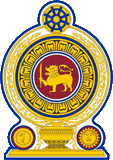 |
seit/since 1972, Wappen von Sri Lanka – coat of arms of Sri Lanka, Quelle/Source, nach/by: Corel Draw 4 |
| Das heutige Staatswappen wurde 1972 angenommen. Bis dahin wurde ein ähnliches Emblem aus dem Jahre 1948 verwendet. Das Wappen zeigt innerhalb eines "Palapeti Vitaya" genannten Ähren- und Lotuskranzes eine golden umrandete rotbraune Scheibe mit dem schwerttragenden Löwen von Kandy. Darunter die Tasse "Punkalasa" zwischen Mond und Sonne. Das Wappen ist bekrönt vom buddhistischen Gesetzesrad, dem "Dschammatschakra". |
The today’s coat of arms
of Sri Lanka was adopted in 1972. Until then, a similar emblem was used,
from 1948. The coat of arms shows a golden-rimmed, reddish brown disc with the sword-bearing lion of Kandy within a wreath of ears and lotus, called "Palapeti Vitaya". Below is placed a cup called "Punkalasa" between moon and sun. The coat of arms is crowned by the Buddhist wheel of law, the "Jammachakra". |
| Quelle/Source: Flaggen Wappen Hymnen | |
Flugzeugkokarde – aircraft roundel: |
|
 |
1951–2010, Flugzeugkokarde – aircraft roundel Quelle/Source, nach/by Wikipedia (EN) |
 |
seit/from 2010, Flugzeugkokarde – aircraft roundel Quelle/Source, nach/by Wikipedia (EN) |
Landkarte – Map: |
Lage – Position: |
Landkarte des Landes – Map of the Country: |
|
|
| Zahlen und Fakten – Numbers and Facts: | |
|
|
|
|
|
|
|
|
|
|
|
|
|
|
|
|
|
|
|
|
|
Antike
· die Insel Ceylon ist bei den Römern als Taprobane bekannt, im
buddhistischen Indien wird sie später Sihaladipa genannt 6. Jahrhundert v.Chr. · Singhalesen aus Indien erobern Ceylon, Abdrängen der Wedda-Urbevölkerung 3. Jahrhundert v.Chr. · Beginn der Einwanderung von Tamilen aus Indien, später auch regelrechte Invasionen 247 v.Chr. · Einführung des Buddhismus 10.–15. Jahrhundert n.Chr. · im Norden Ceylons bilden sich tamilische Königreiche 15. Jahrhundert n.Chr. · im Süden entsteht das singhalesische Königreich Kandy (Königreich Udarata) 15.11.1505 · der portugiesische Seefahrer Lourenço de Almeida landet in Ceylon (Singhalesisches Königreich Kotte), und unterstellt es portugiesischer Oberhoheit, Bau der Festung Colombo 1518 · die Portugiesen ernennen Colombo zur Hauptstadt des Königreichs Kotte 27.05.1597 · der König von Kotte stirbt ohne Nachkommen, das Erbe geht an den König von Portugal 1619 · die Portugiesen erobern Jaffna im Norden und beherrschen nun ganz Ceylon (Ceilão), die Insel wird von Goa in Indien aus verwaltet 1639–1640 · die Niederländer landen im Osten und Süden der Insel und errichten im Auftrag der Niederländischen Ostindienkompanie Stützpunkte (Trincomalee, Batticaloa, Galle), und stoßen später allmählich in Richtung Colombo vor 1656 · die Niederländer erobern Colombo, die Portugiesen ziehen sich nach Jaffna zurück 1658 · die Niederländer erobern Jaffna und beherrschen nun fast ganz Ceylon (außer das Königreich Kandy im zentralen Bergland) 1765 · die Niederländer beherrschen kurzzeitig das Königreich Kandy 1782 · die Briten beherrschen Trincomalee 1782–1784 · die Franzosen beherrschen Trincomalee 1795 · die Britische Ostindienkompanie landet im Osten und Norden der Insel und erobert Trincomalee, Batticaloa und Jaffna 1796 · die Britisch Ostindische Kompanie erobert Colombo und beherrscht nun ganz Ceylon (außer das Königreich Kandy im Mittleren Bergland), die Insel wird von Madras in Indien aus verwaltet 1802 · Ceylon wird Britische Kronkolonie 1815–1817 · das Königreich Kandy wird erobert, und bis zum Oktober 1818 der Britischen Kronkolonie Ceylon angeschlossen 04.02.1948 · Großbritannien gewährt Ceylon die Unabhängigkeit, Ceylon verbleibt im British Commonwealth of Nations 1955 · Ceylon wird Mitglied der UNO 22.05.1972 · Ceylon wird Republik, Proklamation der Republik Sri Lanka 07.09.1978 · neue Verfassung, Demokratische Sozialistische Republik Sri Lanka 1983–1987 · Bürgerkrieg zwischen Tamilen und Singhalesen, die Tamilen fordern die Unabhängigkeit für einen Tamilenstaat "Tamil Eelam" 1987 · Friedensabkommen zwischen der Regierung Sri Lankas und der Tamilischen LTTE-Miliz, Indische Truppen überwachen den Frieden (LTTE = Liberation Tigers of Tamil Eelam) 1988 · die Tamilischen Milizen greifen die Indischen Truppen an 1990 · die Indischen Truppen verlassen die Insel 1990–1995 · Bürgerkrieg zwischen Regierungstruppen und Tamilen, Jaffna (die Hauptstadt der Tamilen) wird durch erobert, die LTTE-Miliz verzichtet auf die Forderung nach Autonomiegebieten 1996 · Fortsetzung der Kämpfe zwischen Regierungstruppen und Tamilen 2009 · vollständiger militärischen Sieg der sri-lankischen Regierungstruppen über die LTTE-Miliz, Ende des bewaffneten Tamilischen Separatismus |
|
Antiquity
· Ceylon Island is known in the Roman Empire as Taprobane, in the buddhist
India it is later called Sihaladipa 6th century B.C. · Singhalese from India conquer Ceylon, push aside of the native population of Wedda 3rd century B.C. · onset of the immigration of Tamils from India, later even right invasions 247 B.C. · introduction of Buddhism 10th–15th century A.D. · in the north of Ceylon arise Tamil kingdoms 15th century A.D. · in the south arises the Singhalese kingdom of Kandy (Kingdom of Udarata) 15th of November 1505 · the Portugese seafarer Lourenço de Almeida debarks in Ceylon (Singhalese Kingdom of Kotte) and subordinates it under Portugese supremacy, erection of the fortification of Colombo 1518 · the Portugese make Colombo to the capital of the Kingdom of Kotte 27th of May 1597 · the King of Kotte dies without descendants, the heritage goes to the King of Portugal 1619 · the Portugese conquer Jaffna in the north and rule now over whole Ceylon (Ceilão), the island ist administered from Goa in India 1639–1640 · the Dutch debark in the east and south of the island and establish on behalf of the Dutch East India Company bases (Trincomalee, Batticaloa, Galle) and push later gradually forward in direction of Colombo 1656 · the Dutch conquer Colombo, the Portugese retreat to Jaffna 1658 · the Dutch conquer Jaffna and rule now over nearly whole Ceylon (except the Kingdom of Kandy in the central mountainous region) 1765 · the Dutch rule momentary over the Kingdom of Kandy 1782 · the British rule in Trincomalee 1782–1784 · the Frenchman rule in Trincomalee 1795 · the British East India Company debarks in the east and north of the island and conquers Trincomalee, Batticaloa and Jaffna 1796 · the British East India Company conquers Colombo and rules now over nearly whole Ceylon (except the Kingdom of Kandy in the middle mountains), the island is administered from Madras in India 1802 · Ceylon becomes a British crown colony 1815–1817 · the Kingdom of Kandy becomes conquered and affiliated to the British crown colony of Ceylon until October 1818 4th of February in 1948 · United Kingdom grants Ceylon the independence, Ceylon remains in the British Commonwealth of Nations 1955 · Ceylon becomes member of the UNO 22nd of May 1972 · Ceylon becomes republic, proclamation of the Republic of Sri Lanka 7th of September 1978 · new constitution, Democratic Socialistic Republic of Sri Lanka 1983–1987 · civil war between Tamils and Singhalese, the Tamils claim independence for a Tamile state "Tamil Eelam" 1987 · peace treaty between the government of Sri Lanka und the Tamil LTTE-militia, Indian troops observe the peace (LTTE = Liberation Tigers of Tamil Eelam) 1988 · the Tamil militia attack the Indian troops 1990 · the Indian troops leave the island 1990–1995 · civil war between governmental troops and Tamils, Jaffna (the capital of the Tamils) becomes conquered, the LTTE-militia disclaims for demands of autonomy areas 1996 · continuation of the fights between governmental troops and Tamils 2009 · complete military victory of Sri Lankan government troops over the LTTE-militia, end of armed Tamil separatism |
| Quelle/Source: Atlas zur Geschichte, World Statesmen, Wikipedia (EN), Volker Preuß |
| Die Insel Ceylon trug unterschiedlichste Namen und wurde von verschiedenen Völkern benamt. Die Römer nannten sie "Taprobane". In der buddhistischen Religionssprache Pali wurde sie "Sihaladipa" genannt, von den Hindus "Sinhala" (Reich der Löwen) und den Arabern "Serendib" (Löweninsel). Der Name "Ceylon" ist europäischen Ursprungs und entstand wahrscheinlich durch Veränderung des Hindi-Wortes "Sinhala" zur portugiesischen Bezeichnung "Ceilão". Die Niederländer und Briten nannten sie schließlich "Ceylon". Die seit 1972 verwendete Bezeichnung "Sri Lanka" für den Staat auf der Insel Ceylon ist Singhalesischen Ursprungs (Tamil: "Ilankai") und heißt "strahlend schönes Land". |
The island of Ceylon has
had many different names and was named by various peoples. The Romans called
it "Taprobane". In the Buddhist religious language Pali it was called
"Sihaladipa", by the Hindus "Sinhala" (kingdom of lions) and by the Arabs
"Serendib" (lion island). The name "Ceylon" is of European origin and was probably created by changing the Hindi word "Sinhala" to the Portuguese name "Ceilão". The Dutch and British called it finally "Ceylon". The name "Sri Lanka", which has been used for the state on the island of Ceylon since 1972, is of Sinhalese origin (Tamil: "Ilankai") and means "radiantly beautiful country". |
| Quelle/Source: Wikipedia (DE), Handbuch der geographischen Namen | |